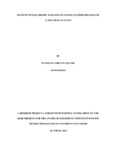| dc.description.abstract | Kenya introduced the Tax Modernisation Programme in 1986 with the hope that this
would, among other things, enhance revenue collection, improve tax administration and
reduce compliance and collection costs. Despite the tax modernization, there are concerns
that the challenges that confront the Ministry of Finance and Kenya Revenue Authority
today are not much different from the challenges that faced these revenue authorities
before the reforms. There are also concerns that tax competitiveness in Kenya is low and
the country remains among the most tax unfriendly countries in the world. This study
reviews tax revenue performance as well as tax design and administration changes during
the period 1996 - 2005 in order to identify priorities for further tax reform. Even though
the tax system has continuously changed, in pursuit of the objectives of the Tax
Modernization Programme that came into force in 1986, the challenges that confront the
tax authorities today are not much different from the pre-reform challenges. With Kenyan
firms reporting that about 68.2% of profit is taken away in taxes, tax competitiveness is
low and the country remains among the most tax unfriendly countries in the world. Tax
evasion remains high, with a tax gap of about 35% and 33.1% in 2000/1 and 2001/2
respectively. The tax code is still complex and cumbersome, characterized by uneven and
unfair taxes, a narrow tax base with very high tax rates and rates dispersions with respect
to trade, and low compliance. Additional challenges include tax systems with rates and
structures that are difficult to administer and comply with; are unresponsive to growth
and discretionary policy hence low productivity; raise little revenue but introduce serious
economic distortions; treat labour and capital in similar circumstances differently; and
are selective and skewed in favour of those with the ability to defeat the tax
administration and enforcement system. Beginning in the mid-1980‘s, tax reforms
became part of the larger Structural Adjustment Programmes that were incorporated in
the economic restructuring agreement between the Government of Kenya and the
International Financial Institutions. Unfortunately, such reforms focused on the Central
Government tax system but left out local government tax reforms. Substantial tax reforms
followed fiscal crises that were being experienced at the time and the resulting pressures
for reform from the IMF and World Bank. The pressure to liberalize happened
simultaneously with the realization within the Government that the economic situation
was untenable. Thus, Kenya‘s tax reform was adopted voluntarily to gain favour with
powerful international donors | en_US |

